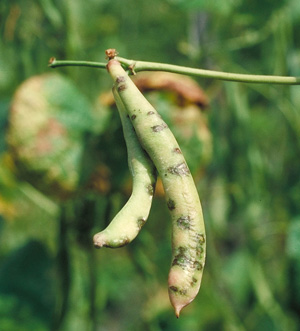G1956
Common Bacterial Blight of Dry Beans in Nebraska
This NebGuide covers common bacterial blight of dry beans and its management.
Robert M. Harveson, Extension Plant Pathologist
Introduction
Common bacterial blight of dry beans has been seen in Nebraska since the crop was first introduced in the 1920s. As the name implies, it’s considered to be a major problem wherever beans are grown, and is the most commonly observed bacterial disease in the Central High Plains. It can be highly destructive during long periods of warm, humid weather, causing reductions in both yield and seed quality.
The last 30 years have seen reduced losses, due to many of today’s cultivars having some resistance to the pathogen. This is due to the work of Coyne and Schuster in Nebraska beginning in the 1960s. Further improvements for managing this problem were realized when seed began to be produced in arid areas of the western United States, instead of being locally produced near commercial production fields in western Nebraska.
Symptoms and Signs
Symptoms begin with small water-soaked spots on the bottom of leaves (Figure 1). The spots enlarge and coalesce becoming brown, dry, and brittle. A narrow, bright lemon-yellow border of tissue often develops around dried, necrotic lesions (Figure 2), which may be found in both interveinal areas and along leaf margins (Figure 3).
Severe infections result in leaves remaining attached to plants, giving a burned appearance to foliage (Figure 4). Affected pods develop circular, water-soaked areas that may also have yellow masses of bacteria observed on lesions. Later, spots on pods become reddish-brown and sunken (Figure 5). Early pod infection results in small, shriveled and discolored seed.
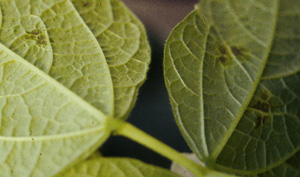 |
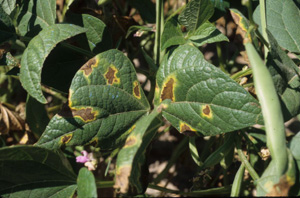 |
|||
| Figure 1. Early symptoms of common blight showing small water-soaked lesions on the underside of leaves. | Figure 2. Narrow lemon-yellow halo surrounding large necrotic lesion, characteristic of common blight. | |||
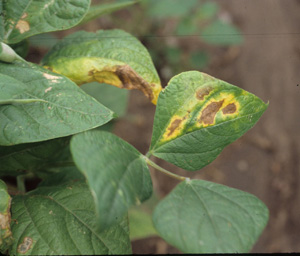 |
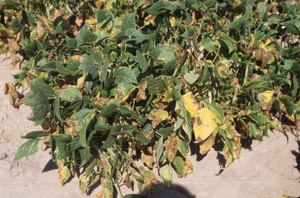 |
|||
| Figure 3. Common blight lesions present in both interveinal areas and margins of leaves. | Figure 4. Severe infection from common blight showing burned appearance to leaves. | |||
|
||||
Pathogen and Disease Cycle
Xop is gram-negative, aerobic, rod-shaped, and moves via a tail called a flagellum. Xop is identified by its production of a carotenoid, non-water soluble pigment, giving bacterial colonies a mucoid, bright-yellow growth in culture (Figure 6).
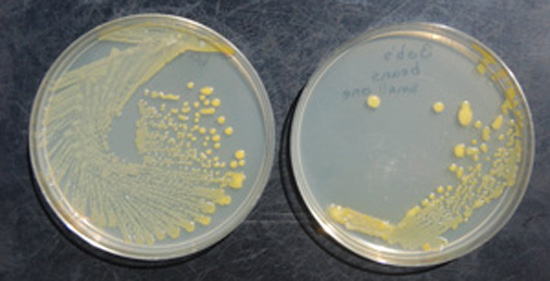 |
| Figure 6. Bright lemon-yellow bacterial colonies characteristic of the common blight pathogen growing in culture. |
In Nebraska, another pathogen, originally considered a variant of Xop, causes the disease called fuscous blight. Lab analyses differentiates this bacterium from Xop by its production of a diffusible, brown pigment (melanin) on growth media which contains amino acid tyrosine or through sophisticated genetic analyses. These pigment-producing isolates tend to be more highly infectious of than those Xop. Common and fuscous blight pathogens are very similar in both culture media and symptom development and often occur in fields simultaneously.
Common bacterial blight is a warm-weather disease, and the greatest damage to bean plants occurs when air temperatures are 82°F to 90°F (28° to 32°C). These conditions commonly occur in the Central High Plains during the late vegetative to early flowering stages of plant growth. The pathogen can overwinter and survive in the field on infected seed and plant debris. It has additionally been shown to survive as an epiphyte (an organism that can survive on the external leaves of another plant ) on symptomless onion plants grown in fields cropped with dry beans the previous year. Planting dry beans next to a field blighted the year before can expose it to potential infection. The bacterium can spread rapidly from infected to healthy plants, within or among fields, by high winds, rain, irrigation water or hail storms, people and machinery (Figure 7).
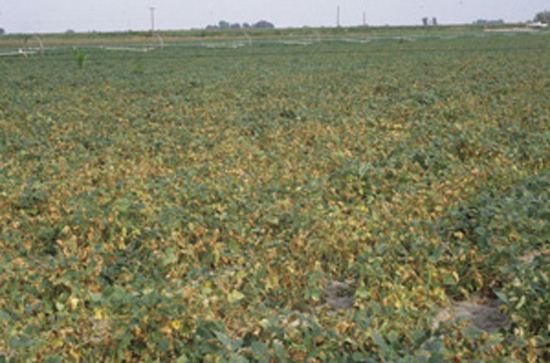 |
| Figure 7. Severe field infection showing effects of pathogen spread after summer thunderstorms. Note also the side-roll type of sprinkler irrigation equipment in the background. Bacterial infections and spread are enhanced by sprinkler irrigation. |
Management
Chemical Methods: Chemical control results vary depending on pathogen, weather and disease pressure. Increased yields have been realized for fields with halo blight and brown spot infections through use of copper-based applications 40 days after emergence (mid-vegetative or early flowering periods) and then repeated every seven to 10 days for a total of three applications.
Control of common blight with copper sprays has not been as consistent as with halo blight and brown spot, but may still be of some benefit by reducing disease spread. Microbial resistance to copper has been reported for this pathogen.
Cultural Methods:
- Do not save seed from previously blighted fields for re-use.
- Plant certified seed of disease-resistant cultivars where possible.
- Plant seed treated with streptomycin to help reduce contamination of the seed coat and establish a vigorous early-season stand.
- Rotate beans with other crops for two to three years.
- Incorporate infected bean residues after harvest.
- Eliminate bean volunteers during growing season.
- Stay out of bean fields when wet. Moving through blighted fields when foliage is wet can spread pathogen to other plants.
- Do not spread old bean straw from infested crops on new fields to be used for bean production.
- Avoid re-using irrigation water.
- Do not plant beans close to recently blighted fields.
This publication has been peer reviewed.
Visit the University of Nebraska–Lincoln Extension Publications Web site for more publications.
Index: Plant Diseases
Dry Beans
Issued July 2009
